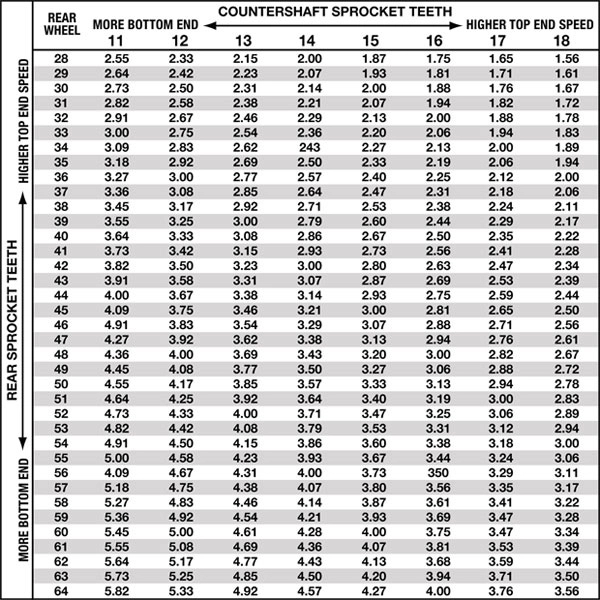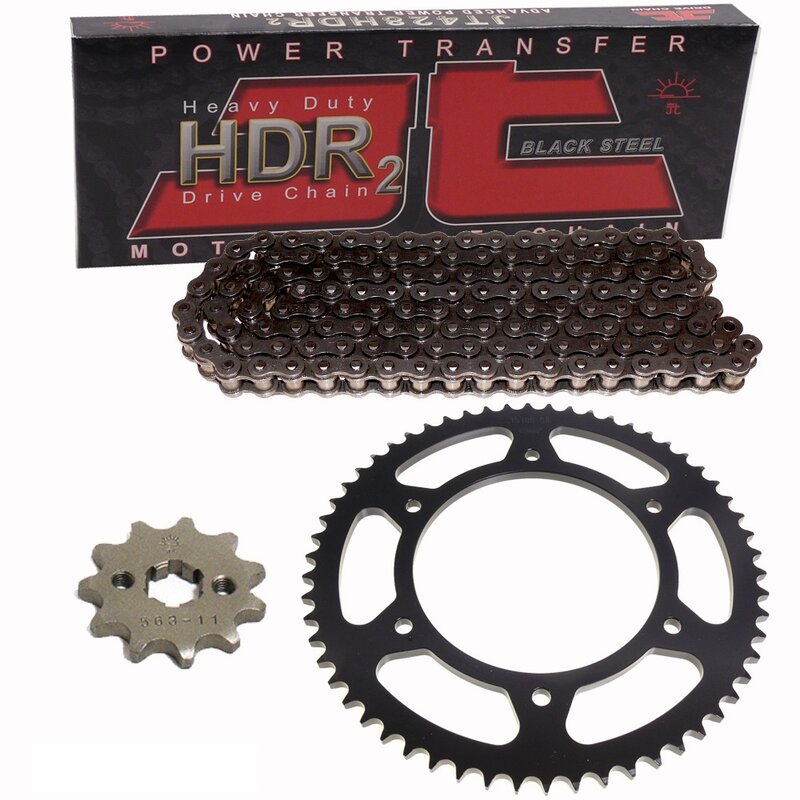Motorcycle Sprocket Gear Ratios.
Sprocket changes could result in smoother cruising or quicker acceleration.
The final-drive ratio, which is obtained by dividing the number of teeth on the rear sprocket by the number of teeth on the front, or countershaft sprocket, is what we refer to when we talk about gearing. In the end, this statistic defines how engine rpm translates to road speed and how much power there is at the rear wheel. It shows how many times the front sprocket must rotate to turn the rear sprocket.
The Various Gear Ratio Types.

Let's address terminology before we go into the details. When a bike is described as having "tall" or "high" gearing, it suggests that acceleration will suffer in exchange for a higher top speed. When gearing is described as "short" or "low," it signifies that the top speed is lower but the acceleration is better. The confusing portion is right here. Shorter gearing corresponds to a higher gear ratio, such as 3.10, whereas taller gearing corresponds to a lower number, such as 2.70. It all comes down to how many rotations the front sprocket needs to make in order to turn the wheel and the rear sprocket.
The good news is that while running numbers through a calculator to compare ratios is useful, it is not required. Your bike's present gearing is printed right on the side of the sprockets, so all you really need to do is identify it before determining how to change the tooth count to improve performance.
You should decrease your gearing by either removing teeth from the front sprocket or adding teeth to the rear sprocket if you ride a small-displacement bike or frequently ride in cities or particularly narrow lanes and want improved off-the-line acceleration. You should either add teeth to the front or take teeth away from the back if you want to obtain better fuel economy and lower rpms as you drive down the motorway.
Since many modern motorcycles have overly tall gearing, riders typically gear their bikes shorter. However, you typically won't need to modify the tooth count much to notice a significant difference, even if a bike feels like the gearing is drastically out of proportion to the way you ride. Typically, users will adjust the front sprocket by one to two teeth and the rear sprocket by a maximum of three teeth.
Should I Replace My Chain If I Replace My Sprockets?
Make sure to fix the chain tension if you change your gearing, even by a single tooth, as this will alter the sprocket's diameter and the amount of chain slack. If you're going big on the rear, you might discover that you need a longer chain, but most minor gearing changes of just a tooth or two can be accounted for with the available adjustment at the swingarm. However, you don't want to mess with your wheelbase too much. Additionally, you should replace the entire drivetrain as a set if it has a lot of miles on it to ensure that it wears evenly. A worn chain will quickly be destroyed if a new sprocket is thrown at it.
Speedometer Changes and Gearing.
When altering your gearing, keep in mind that your speedometer may be impacted. The majority of motorcycles measure their speed in relation to the gearbox, so changing the final-drive gearing will skew the ECU's calculations. You're safe if you ride an older bike with a front-wheel speed sensor, but if not, you might want to think about purchasing a SpeedoHealer or a similar calibration tool.
What Sprocket Should I Change First?
Now, the simplest and least expensive thing to do is to change the front sprocket if you're on a tight budget or simply want to experiment to see how a gearing change impacts your bike. For starters, front sprockets cost around £5 to £15, require less hardware to hold them in place, and even a single tooth adjustment on the front wheel has a greater impact on the gear ratio than a tooth change on the back wheel. The rear wheel must be removed to replace the rear sprockets, which are more expensive.
Finally, there are two alternatives when looking to purchase replacement sprockets: either follow the OE way, which will probably involve stamped steel, or turn to the aftermarket, where you can find a number of aluminium and steel possibilities. For street riders who put a lot of miles on their bikes, aluminium may not be the greatest material because it is significantly lighter but also less durable. A hybrid sprocket like the SuperSprox can help in this situation since it marries a durable steel chain ring to a light aluminium carrier, giving you reduced mass and good durability. Additionally, if your bike has a belt or shaft drive, you're essentially limited to the gearing you have. Although not impossible, changing the final-drive ratio on certain bikes is difficult.
What Are Some Of The Most Popular Brands Of Motorcycle Chain and Sprocket Kits?

JT - The most popular brand of sprockets for motorcycles and ATVs in the world is JT Sprockets. The series offers you the best replacement sprockets at an amazing price by manufacturing them using only the finest raw materials and cutting-edge technology.
Supersprox - produce some of the most cutting-edge sprockets in the world. The Stealth version combines the strength of steel with the weight-saving properties of alloy, combining a durable steel exterior with a lightweight aluminium inside. Stealth will endure twice as long as cheap steel sprockets and three times as long as aluminium. The sprocket's cost-to-life ratio is significantly cheaper than that of aluminium since it lasts three times as long.
DID - The X-Ring chain from D.I.D is made for powerful motorcycles. Their innovative X-Ring design results in a chain that has exceptional wear resistance and reduced friction. The special "V" grease that D.I.D uses in the pin/bushing area of their sealed chains is sealed by specially engineered seal-rings that keep dirt out. Under appropriate maintenance, they should last at least 10 times as long as ordinary chains without experiencing substantial wear elongation.
Renthal - In-house product design, development, and production are all done by Renthal at their UK facilities in Manchester, England. The advantage they have over their rivals comes from their capacity to utilise the top race teams and riders in the world to continuously develop and improve their products.
Esjot - sprockets are among the best available on the market today and were created specifically to meet the strict OEM criteria. Diamond Cut 2.0 technology is used to create extraordinary high quality and durable sprockets.

